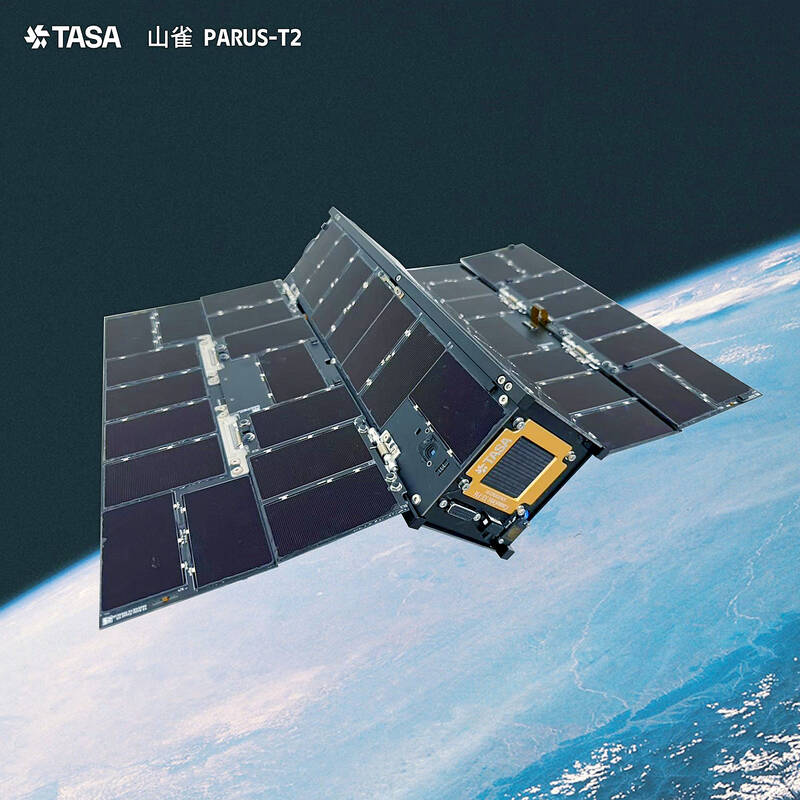The PARUS-T2 Cube Satellite was launched into space by SpaceX Transporter 14 from the Vandenberg Space Force Base in California early yesterday morning.
The satellite, which was developed by the Taiwan Space Agency (TASA), entered low Earth orbit approximately 136 minutes after the launch. Communications with an overseas ground station began about two hours afterward.
It was scheduled to begin communications with a ground station in Taiwan at 10pm yesterday.

Photo courtesy of the Taiwan Space Agency
The PARUS-T2 satellite was built by enhancing the core systems of PARUS-T1, which was launched in January, including improvements to the onboard computer, power control system, satellite battery and the satellite-compatible global navigation satellite system receiver.
It also features a newly designed solar panel deployment mechanism and incorporates a spherical motor-based attitude determination and control system developed by the Taiwanese company Tensor Tech (張量科技).
The PARUS-T2 satellite includes two Taiwan-developed communications payloads — a cross-band voice repeater and an automatic packet reporting system.
The purpose of the PARUS-T2 launch is to verify the functions of the satellite, TASA said, adding that the results would be used to enhance the reliability of homemade cube satellites and provide a platform for researchers to develop standardized cube satellites. The satellite is expected to last for one year.
“In the future, they only need to develop satellites to be included in the payload, which would shorten research-and-development time and increase the chances of a successful verification,” TASA said.
The next TASA cube satellite to be launched would be PARUS-6U1, which would be deployed into space by SpaceX’s Transporter 15 in October, it said.
Aside from the first satellite of Formosat-8, FS-8A, other satellites in the same payload include T.MicroSat-1 developed by Tron Future Tech (創未來科技), RIoT-1 by Rapidtek Technologies, TORO 2 by Pyras Technology Inc (芳興科技), as well as Lilium-2 and Lilium-3 jointly created by National Cheng Kung University, National Taiwan University, National Taiwan University of Science and Technology, and Tamkang University.
In related news, the Ministry of Digital Affairs yesterday said that businesses can apply to use radio frequencies to launch direct-to-device satellite services and other applications following changes to the regulations.
The ministry proposed regulation changes as satellite communication services can now be made available at relatively cheaper prices than before due to lower operational costs. At the initial stage, the ministry would open seven sets of frequency bands for mobile satellite services. Twelve sets of frequency bands are now reserved for the use of fixed satellite services, up from four in the ministry’s plan.
Permissions to use the frequency would be extended to five years from two years, the ministry said.
According to the International Telecommunication Union, fixed communication frequency bands are commonly used for point-to-point communication services, such as broadband Internet, submarine cable backup, maritime communications and satellite news gathering vehicles, Department of Resources Management Director-General Tseng Wen-fang (曾文方) said.
Mobile communication frequency bands, on the other hand, are used for mobile communications services, such as satellite phones and search-and-rescue positioning devices, she said.
The availability of direct-to-device satellite services, which allow people to access satellite communications services directly from their mobile phones, depends on the business plans of the operators, Tseng said.
People might be more willing to subscribe to such services if there are telecom plans similar to the one created through the partnership between Apple Inc and Globalstar Inc, which allows iPhone users to access satellite services free of charge for two years, she said.
In some nations, satellite communication services are available free of charge to customers who pay high monthly telecom fees, which helps increase average revenue per user, she added.
Four companies have filed five applications to offer fixed satellite services — two from Chunghwa Telecom Co (中華電信), one from Lung Hwa Electronics (隴華電子), one from Aerkomm Inc (愛爾康) and one from Teleport Access Services (台亞衛星).
Chunghwa Telecom announced that it is able to offer OneWeb low Earth orbit satellite services after having secured the nation’s first government-issued permit earlier this month.
The ministry said that it has yet to receive an application for low Earth orbit satellite services from Starlink.

The US government has signed defense cooperation agreements with Japan and the Philippines to boost the deterrence capabilities of countries in the first island chain, a report by the National Security Bureau (NSB) showed. The main countries on the first island chain include the two nations and Taiwan. The bureau is to present the report at a meeting of the legislature’s Foreign Affairs and National Defense Committee tomorrow. The US military has deployed Typhon missile systems to Japan’s Yamaguchi Prefecture and Zambales province in the Philippines during their joint military exercises. It has also installed NMESIS anti-ship systems in Japan’s Okinawa

‘WIN-WIN’: The Philippines, and central and eastern European countries are important potential drone cooperation partners, Minister of Foreign Affairs Lin Chia-lung said Minister of Foreign Affairs Lin Chia-lung (林佳龍) in an interview published yesterday confirmed that there are joint ventures between Taiwan and Poland in the drone industry. Lin made the remark in an exclusive interview with the Chinese-language Liberty Times (the Taipei Times’ sister paper). The government-backed Taiwan Excellence Drone International Business Opportunities Alliance and the Polish Chamber of Unmanned Systems on Wednesday last week signed a memorandum of understanding in Poland to develop a “non-China” supply chain for drones and work together on key technologies. Asked if Taiwan prioritized Poland among central and eastern European countries in drone collaboration, Lin

BACK TO WORK? Prosecutors said they are considering filing an appeal, while the Hsinchu City Government said it has applied for Ann Kao’s reinstatement as mayor The High Court yesterday found suspended Hsinchu mayor Ann Kao (高虹安) not guilty of embezzling assistant fees, reducing her sentence to six months in prison commutable to a fine from seven years and four months. The verdict acquitted Kao of the corruption charge, but found her guilty of causing a public official to commit document forgery. The High Prosecutors’ Office said it is reviewing the ruling and considering whether to file an appeal. The Taipei District Court in July last year sentenced Kao to seven years and four months in prison, along with a four-year deprivation of civil rights, for contravening the Anti-Corruption

NO CONFIDENCE MOTION? The premier said that being toppled by the legislature for defending the Constitution would be a democratic badge of honor for him Premier Cho Jung-tai (卓榮泰) yesterday announced that the Cabinet would not countersign the amendments to the local revenue-sharing law passed by the Legislative Yuan last month. Cho said the decision not to countersign the amendments to the Act Governing the Allocation of Government Revenues and Expenditures (財政收支劃分法) was made in accordance with the Constitution. “The decision aims to safeguard our Constitution,” he said. The Constitution stipulates the president shall, in accordance with law, promulgate laws and issue mandates with the countersignature of the head of the Executive Yuan, or with the countersignatures of both the head of the Executive Yuan and ministers or